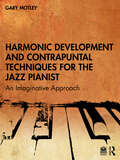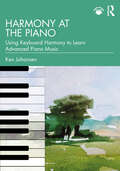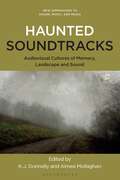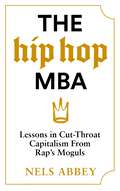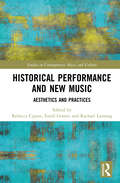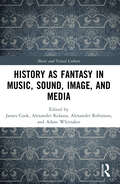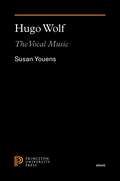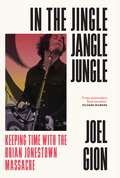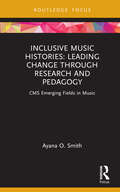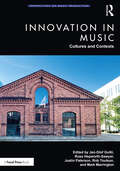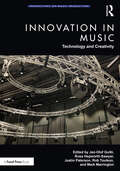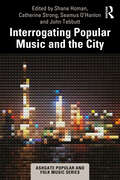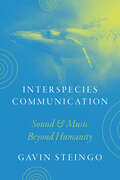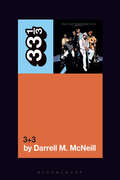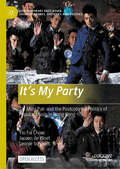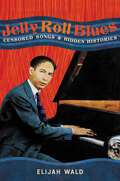- Table View
- List View
»Hands Across the Sea« - John Philip Sousa und der musikalische Amerikanismus in Kontinentaleuropa (Musik und Klangkultur #60)
by Tobias FaßhauerDer Dirigent und Komponist John Philip Sousa (1854-1932) war eine Ikone der amerikanischen Massenkultur um 1900. Seine Märsche und die internationalen Tourneen seines zivilen Blasorchesters machten ihn zu einem der bekanntesten Musiker seiner Zeit. Tobias Faßhauer zeichnet erstmals Sousas kontinentaleuropäische Konzertreisen nach, um seine Rolle im frühen Transfer amerikanischer populärer Musik nach Europa aufzudecken. Eingebettet in den Kontext der Debatte über Amerikanismus zu Beginn des 20. Jahrhunderts entsteht so ein luzides Bild von der Rezeption und dem Einfluss Sousas auf die europäische Musik.
Harmonic Development and Contrapuntal Techniques for the Jazz Pianist: An Imaginative Approach
by Gary MotleyHarmonic Development and Contrapuntal Techniques for the Jazz Pianist serves as a guide for harmonic expansion and development for jazz piano, offering pianists both a rationale and methods to improve contrapuntal hand techniques. The text focuses on the relationship between theory and execution and both of those components’ usefulness in creating a jazz sound at the piano. This kinaesthetic method provides the learner with a systematic approach to harmonic movement, revealing options that may not have been otherwise apparent. This method will allow pianists to add depth and dimension to their chord voicings in the same way that vocalists and wind instrumentalists give character and shape to the notes they create. Key features include musical examples ranging from singular chord construction to sophisticated harmonic progressions and song application. Performance exercises are provided throughout the text. Learners and instructors are encouraged to create their own exercises. Related ancillaries at harmoniccounterpoint.com include: Musical examples Audio tracks Performance exercises Written assignments Intended for the learner who is reasonably familiar with essential jazz harmony, this textbook will be both a significant resource for the advanced player and a fundamental component for the learner in a structured academic musical setting.
Harmonic Development and Contrapuntal Techniques for the Jazz Pianist: An Imaginative Approach
by Gary MotleyHarmonic Development and Contrapuntal Techniques for the Jazz Pianist serves as a guide for harmonic expansion and development for jazz piano, offering pianists both a rationale and methods to improve contrapuntal hand techniques. The text focuses on the relationship between theory and execution and both of those components’ usefulness in creating a jazz sound at the piano. This kinaesthetic method provides the learner with a systematic approach to harmonic movement, revealing options that may not have been otherwise apparent. This method will allow pianists to add depth and dimension to their chord voicings in the same way that vocalists and wind instrumentalists give character and shape to the notes they create. Key features include musical examples ranging from singular chord construction to sophisticated harmonic progressions and song application. Performance exercises are provided throughout the text. Learners and instructors are encouraged to create their own exercises. Related ancillaries at harmoniccounterpoint.com include: Musical examples Audio tracks Performance exercises Written assignments Intended for the learner who is reasonably familiar with essential jazz harmony, this textbook will be both a significant resource for the advanced player and a fundamental component for the learner in a structured academic musical setting.
Harmony at the Piano: Using Keyboard Harmony to Learn Advanced Piano Music
by Ken JohansenHarmony at the Piano adapts the traditional study of keyboard harmony to the practical needs of modern piano students, using innovative exercises to help students practice their repertoire more deliberately, consciously, and creatively. The author introduces the essential elements of harmony through extensive examples from real piano music. Rooted in the understanding that the language of tonal harmony is best assimilated at the keyboard, this textbook: Gives students effective practice methods for learning repertoire, including techniques for memorizing music in a deliberate, analytical way. Connects harmony to musical expression, enabling students to make interpretive decisions based on their understanding of harmony. Contains extensive practice drills in each chapter, including chord progressions, figured bass, melody harmonization, reduction techniques, transposition, repertoire study, and more. Designed to support a full college or conservatory course in keyboard harmony, this book clearly connects the study of harmony to practical musicianship and keyboard skills, providing an essential resource for all instructors and students of advanced piano music. Extensive online resources complement this textbook, including suggested realizations of the figured bass exercises, the original scores of the melody harmonization and fill-in-the-blank exercises, as well as additional exercises and examples.
Harmony at the Piano: Using Keyboard Harmony to Learn Advanced Piano Music
by Ken JohansenHarmony at the Piano adapts the traditional study of keyboard harmony to the practical needs of modern piano students, using innovative exercises to help students practice their repertoire more deliberately, consciously, and creatively. The author introduces the essential elements of harmony through extensive examples from real piano music. Rooted in the understanding that the language of tonal harmony is best assimilated at the keyboard, this textbook: Gives students effective practice methods for learning repertoire, including techniques for memorizing music in a deliberate, analytical way. Connects harmony to musical expression, enabling students to make interpretive decisions based on their understanding of harmony. Contains extensive practice drills in each chapter, including chord progressions, figured bass, melody harmonization, reduction techniques, transposition, repertoire study, and more. Designed to support a full college or conservatory course in keyboard harmony, this book clearly connects the study of harmony to practical musicianship and keyboard skills, providing an essential resource for all instructors and students of advanced piano music. Extensive online resources complement this textbook, including suggested realizations of the figured bass exercises, the original scores of the melody harmonization and fill-in-the-blank exercises, as well as additional exercises and examples.
Haunted Soundtracks: Audiovisual Cultures of Memory, Landscape, and Sound (New Approaches to Sound, Music, and Media)
by K. J. Donnelly and Aimee MollaghanThe turn of the millennium has heralded an outgrowth of culture that demonstrates an awareness of the ephemeral nature of history and the complexity underpinning the relationship between location and the past. This has been especially apparent in the shifting relationship between landscape, memory and sound in film, television and other media. The result is growing interest in soundtracks, as part of audiovisual culture, as well as an interest in the spectral aspects of culture more generally. This collection of essays focuses on audiovisual forms that foreground landscape, sound and memory. The scope of inquiry emphasises the ghostly qualities of a certain body of soundtracks, extending beyond merely the idea of 'scary films' or 'haunted houses.' Rather, the notion of sonic haunting is tied to ideas of trauma, anxiety or nostalgia associated with spatial and temporal dislocation in contemporary society. Touchstones for the approach are the concepts of psychogeography and hauntology, pervasive and established critical strategies that are interrogated and refined in relation to the reification of the spectral within the soundtracks under consideration here.
The Hip-Hop MBA: Lessons in Cut-Throat Capitalism from Rap’s Moguls
by Nels AbbeyWhat does the founding of the Sugarhill Gang teach us about business development? What can we learn about management and leadership from Jay-Z’s decades-long dominance? What does Ice Cube’s refusal to accept $75,000 to remain a member of NWA tell us about risk management? What can we learn about market dominance from the Death Row and Bad Boy Records beef? What does the rise and fall of MC Hammer (and the near fall of Rihanna) reveal about the psychology of money management? Does Lil Nas X have anything to teach us about corporate diversity? In The Hip Hop MBA, banker–turned–writer Nels Abbey offers an alternative and entertaining look at business and economics through the rise and triumph of Hip Hop. This is the story of how rap industrialists – like Jay-Z, Suge Knight, Sylvia Robinson, Puff Daddy, 50 Cent and Bryan ‘Birdman’ Williams – took chronic economic pain and turned it into champagne. With a business acumen often acquired in the streets, these moguls created and sustained a multi-billion-dollar industry – leaving Greek mythology-worthy stories of success and failure, betrayal and revenge in their wakes. The world of business hasn’t taken Hip Hop moguls or their methods anywhere near seriously enough – until now. The Hip Hop MBA is taking you back to school.
Historical Performance and New Music: Aesthetics and Practices
by Rebecca Cypess, Estelí Gomez, and Rachael LansangThe worlds of new music and historically informed performance might seem quite distant from one another. Yet, upon closer consideration, clear points of convergence emerge. Not only do many contemporary performers move easily between these two worlds, but they often do so using a shared ethos of flexibility, improvisation, curiosity, and collaboration—collaboration with composers past and present, with other performers, and with audiences. Bringing together expert scholars and performers considering a wide range of issues and case studies, Historical Performance and New Music—the first book of its kind—addresses the synergies in aesthetics and practices in historical performance and new music. The essays treat matters including technologies and media such as laptops, printing presses, and graphic notation; new music written for period instruments from natural horns to the clavichord; personalities such as the pioneering singer Cathy Berberian; the musically “omnivorous” ensembles A Far Cry and Roomful of Teeth; and composers Luciano Berio, David Lang, Molly Herron, Caroline Shaw, and many others. Historical Performance and New Music presents pathbreaking ideas in an accessible style that speaks to performers, composers, scholars, and music lovers alike. Richly documented and diverse in its methods and subject matter, this book will open new conversations about contemporary musical life.
Historical Performance and New Music: Aesthetics and Practices
The worlds of new music and historically informed performance might seem quite distant from one another. Yet, upon closer consideration, clear points of convergence emerge. Not only do many contemporary performers move easily between these two worlds, but they often do so using a shared ethos of flexibility, improvisation, curiosity, and collaboration—collaboration with composers past and present, with other performers, and with audiences. Bringing together expert scholars and performers considering a wide range of issues and case studies, Historical Performance and New Music—the first book of its kind—addresses the synergies in aesthetics and practices in historical performance and new music. The essays treat matters including technologies and media such as laptops, printing presses, and graphic notation; new music written for period instruments from natural horns to the clavichord; personalities such as the pioneering singer Cathy Berberian; the musically “omnivorous” ensembles A Far Cry and Roomful of Teeth; and composers Luciano Berio, David Lang, Molly Herron, Caroline Shaw, and many others. Historical Performance and New Music presents pathbreaking ideas in an accessible style that speaks to performers, composers, scholars, and music lovers alike. Richly documented and diverse in its methods and subject matter, this book will open new conversations about contemporary musical life.
History as Fantasy in Music, Sound, Image, and Media (Music and Visual Culture)
by James Cook Alexander Kolassa Alexander Robinson Adam WhittakerExploring how music is used to portray the past in a variety of media, this book probes the relationship between history and fantasy in the imagination of the musical past. The volume brings together essays from multidisciplinary perspectives, addressing the use of music to convey a sense of the past in a wide range of multimedia contexts, including television, documentaries, opera, musical theatre, contemporary and historical film, videogames, and virtual reality. With a focus on early music and medievalism, the contributors theorise the role of music and sound in constructing ideas of the past. In three interrelated sections, the chapters problematise notions of historical authenticity on the stage and screen; theorise the future of musical histories in immersive and virtual media; and explore sound’s role in more fantastical appropriations of history in television and videogames. Together, they poseprovocative questions regarding our perceptions of ‘early’ music and the sensory experience of distant history. Offering new ways to understand the past at the crossroads of musical and visual culture, this collection is relevant to researchers across music, media, and historical and cultural studies.
History as Fantasy in Music, Sound, Image, and Media (Music and Visual Culture)
by James Cook, Alexander Kolassa, Alexander Robinson, and Adam WhittakerExploring how music is used to portray the past in a variety of media, this book probes the relationship between history and fantasy in the imagination of the musical past. The volume brings together essays from multidisciplinary perspectives, addressing the use of music to convey a sense of the past in a wide range of multimedia contexts, including television, documentaries, opera, musical theatre, contemporary and historical film, videogames, and virtual reality. With a focus on early music and medievalism, the contributors theorise the role of music and sound in constructing ideas of the past. In three interrelated sections, the chapters problematise notions of historical authenticity on the stage and screen; theorise the future of musical histories in immersive and virtual media; and explore sound’s role in more fantastical appropriations of history in television and videogames. Together, they poseprovocative questions regarding our perceptions of ‘early’ music and the sensory experience of distant history. Offering new ways to understand the past at the crossroads of musical and visual culture, this collection is relevant to researchers across music, media, and historical and cultural studies.
Hugo Wolf: The Vocal Music
by Susan YouensA groundbreaking look at one of the great song composers of the late Romantic periodIn the virtual cottage industry of works on fin de siècle Vienna, Hugo Wolf (1860–1903) has been somewhat neglected, perhaps because he was the master of a small genre—the late Romantic lied—and never truly made his mark in the larger forms that command greater public attention. But in the realm of song, he is among the greatest inheritors of Schubert and Schumann, one who was both a traditionalist and a modernist. When the Viennese critic Eduard Hanslick disapprovingly dubbed Wolf &“the Richard Wagner of the lied,&” he was paying oblique homage to Wolf&’s genius as a song composer in the most modern manner.In this book, Susan Youens examines five aspects of Wolf&’s compositional art, each exemplifying a different synthesis of traditionalism and modernity and spanning his entire, tragically brief creative life, from his first efforts to his lapse into insanity in 1897. She discusses Wolf&’s youthful imitations of Schumann, his genius for comic songs of a kind unlike any of his predecessors, his part in the ballad revival of the late nineteenth century, Wolf in relation to his contemporaries, and his pursuit of operatic fame. Youens looks as closely at the poetic texts as she does the music and includes numerous previously unpublished sketches and fragments, examples from songs now long out of print and difficult to obtain, and citations from Wolf&’s vivid letters and other sources of the period.
In the Jingle Jangle Jungle: Keeping Time with the Brian Jonestown Massacre
by Joel GionThe Brian Jonestown Massacre are one of the great contemporary cult American rock and roll bands. At the peak of their anarchic reign in the San Francisco underground of the mid '90s their psychedelic output was almost as prodigious and impressive as their narcotic intake. Immortalised in one of the most unforgettable rock and roll documentaries of all time, DIG! alongside their friends/rivals/nemeses, The Dandy Warhol's, in their early years when the US were obsessed with grunge, the BJM felt like a '60s anachronism. But with albums like Their Satanic Majesties Second Request and Thank God for Mental Illness, and incendiary, often chaotic, live shows, they burnished their legend as true believers and custodians of the original west coast flame; a privilege and responsibility which continues to this day when the band have a bigger and more dedicated audience than ever.Joel Gion's memoir tells the story of the first ten years of the band from the Duke Seat. A righteous account of the hazards and pleasures of life on and off the road, In the Jingle Jangle Jungle takes use behind the scenes of the supposed behind the scenes film that cemented the band's legend. Funny as hell, shot through with the innocence and wonder of a 'percussionist' whose true role is that of the band's 'spirit animal', In the Jingle Jangle Jungle is destined to take its place alongside cult classics in the pantheon of rock and roll literature like Playing the Bass with Three Left Hands, Head On, and 45 by Bill Drummond. It will also feature a foreword by Anton Newcombe, fellow member and founder of The Brian Jonestown Massacre.
Inclusive Music Histories: CMS Emerging Fields in Music (CMS Emerging Fields in Music)
by Ayana O. SmithInclusive Music Histories: Leading Change through Research and Pedagogy models effective practices for researchers and instructors striving either to reform music history curricula at large or update individual topics within their classes to be more inclusive. Confronting racial and other imbalances of Western music history, the author develops four core principles that enable a shift in thinking to create a truly intersectional music history narrative and provides case studies that can be directly applied in the classroom. The book addresses inclusivity issues in the discipline of musicology by outlining imbalances encoded into the canonic repertory, pedagogy, and historiography of the field. This book offers comprehensive teaching tools that instructors can use at all stages of course design, from syllabus writing and lecture planning to discussion techniques, with assignments for each of the subject matter case studies. Inclusive Music Histories enables instructors to go beyond token representation to a more nuanced music history pedagogy.
Inclusive Music Histories: CMS Emerging Fields in Music (CMS Emerging Fields in Music)
by Ayana O. SmithInclusive Music Histories: Leading Change through Research and Pedagogy models effective practices for researchers and instructors striving either to reform music history curricula at large or update individual topics within their classes to be more inclusive. Confronting racial and other imbalances of Western music history, the author develops four core principles that enable a shift in thinking to create a truly intersectional music history narrative and provides case studies that can be directly applied in the classroom. The book addresses inclusivity issues in the discipline of musicology by outlining imbalances encoded into the canonic repertory, pedagogy, and historiography of the field. This book offers comprehensive teaching tools that instructors can use at all stages of course design, from syllabus writing and lecture planning to discussion techniques, with assignments for each of the subject matter case studies. Inclusive Music Histories enables instructors to go beyond token representation to a more nuanced music history pedagogy.
Innovation in Music: Cultures and Contexts (ISSN)
Innovation in Music: Cultures and Contexts is a groundbreaking collection bringing together contributions from instructors, researchers, and professionals. Split into two sections, covering creative production practices and national/international perspectives, this volume offers truly global outlooks on ever-evolving practices.Including chapters on Dolby Atmos, the history of distortion, creativity in the pandemic, and remote music collaboration, this is recommended reading for professionals, students, and researchers looking for global insights into the fields of music production, music business, and music technology.
Innovation in Music: Cultures and Contexts (ISSN)
by Jan-Olof Gullö Russ Hepworth-Sawyer Justin Paterson Rob Toulson Mark MarringtonInnovation in Music: Cultures and Contexts is a groundbreaking collection bringing together contributions from instructors, researchers, and professionals. Split into two sections, covering creative production practices and national/international perspectives, this volume offers truly global outlooks on ever-evolving practices.Including chapters on Dolby Atmos, the history of distortion, creativity in the pandemic, and remote music collaboration, this is recommended reading for professionals, students, and researchers looking for global insights into the fields of music production, music business, and music technology.
Innovation in Music: Technology and Creativity (ISSN)
Innovation in Music: Technology and Creativity is a groundbreaking collection bringing together contributions from instructors, researchers, and professionals. Split into two sections, covering composition and performance, and technology and innovation, this volume offers truly international perspectives on ever-evolving practices.Including chapters on audience interaction, dynamic music methods, AI, and live electronic performances, this is recommended reading for professionals, students, and researchers looking for global insights into the fields of music production, music business, and music technology.
Innovation in Music: Technology and Creativity (ISSN)
by Jan-Olof Gullö Russ Hepworth-Sawyer Justin Paterson Rob Toulson Mark MarringtonInnovation in Music: Technology and Creativity is a groundbreaking collection bringing together contributions from instructors, researchers, and professionals. Split into two sections, covering composition and performance, and technology and innovation, this volume offers truly international perspectives on ever-evolving practices.Including chapters on audience interaction, dynamic music methods, AI, and live electronic performances, this is recommended reading for professionals, students, and researchers looking for global insights into the fields of music production, music business, and music technology.
Interrogating Popular Music and the City (ISSN)
by Catherine Strong Shane Homan Seamus O'Hanlon John TebbuttHow does popular music influence the culture and reputation of a city, and what does a city do to popular music? Interrogating Popular Music and the City examines the ways in which urban environments and music cultures intersect in various locales around the globe. Music and cities have been partners in an often clumsy, sometimes accidental but always exciting dance. Heritage and immigration, noise and art, policy and politics are some of the topics that are addressed in this critical examination of relationships between cities and music. The book draws upon an international array of researchers, encompassing hip hop in Beijing; the city favelas of Brazil; from Melbourne bars to European parliaments; to heritage and tourism debates in Salzburg and Manchester. In doing so, it interrogates the different agendas of audiences, musicians and policy-makers in distinct urban settings.
Interrogating Popular Music and the City (ISSN)
How does popular music influence the culture and reputation of a city, and what does a city do to popular music? Interrogating Popular Music and the City examines the ways in which urban environments and music cultures intersect in various locales around the globe. Music and cities have been partners in an often clumsy, sometimes accidental but always exciting dance. Heritage and immigration, noise and art, policy and politics are some of the topics that are addressed in this critical examination of relationships between cities and music. The book draws upon an international array of researchers, encompassing hip hop in Beijing; the city favelas of Brazil; from Melbourne bars to European parliaments; to heritage and tourism debates in Salzburg and Manchester. In doing so, it interrogates the different agendas of audiences, musicians and policy-makers in distinct urban settings.
Interspecies Communication: Sound and Music beyond Humanity
by Gavin SteingoA surprising study reveals a plethora of attempts to communicate with non-humans in the modern era. In Interspecies Communication, music scholar Gavin Steingo examines significant cases of attempted communication beyond the human—cases in which the dualistic relationship of human to non-human is dramatically challenged. From singing whales to Sun Ra to searching for alien life, Steingo charts the many ways we have attempted to think about, and indeed to reach, beings that are very unlike ourselves. Steingo focuses on the second half of the twentieth century, when scientists developed new ways of listening to oceans and cosmic space—two realms previously inaccessible to the senses and to empirical investigation. As quintessential frontiers of the postwar period, the outer space of the cosmos and the inner space of oceans were conceptualized as parallel realities, laid bare by newly technologized “ears.” Deeply engaging, Interspecies Communication explores our attempts to cross the border between the human and non-human, to connect with non-humans in the depths of the oceans, the far reaches of the universe, or right under our own noses.
The Isley Brothers' 3+3 (33 1/3)
by Darrell M. McNeillThe Isley Brothers' 3+3, dissects The Isleys' 50-year-old undisputed masterwork, an album that firmly established their music dynasty on a global scale, as well as heralding the boldest run of genre-defiant albums of their 67-year career. The 1973 watershed was their first multiplatinum release and is significant as a rare, crossover record by a Black act that struck a chord with urban, rock, and pop consumers, despite the schisms between audiences due to bias-driven media and industry marketing.The book looks at the album from all angles: from The Isleys' early career to their influence on rock and rollers both Black and White, from the twists and turns of having national hits without national recognition, on to their decision to form T-Neck Records and the group's challenges navigating a music industry that racially codified music and hampered Black artists from universal acclaim and compensations. Finally, a summation of the decades follows The Isleys' run and its ups and downs, with a fast-forward to where the group is now after 67 years.
It’s My Party: Tat Ming Pair and the Postcolonial Politics of Popular Music in Hong Kong (Contemporary East Asian Visual Cultures, Societies and Politics)
by Jeroen de Kloet Yiu Fai Chow Leonie SchmidtThis book is unique in focusing on just one band from one city – but the story of Tat Ming Pair, in so many ways, is the story of Hong Kong's recent decades, from the Handover to the Umbrella Movement to 2019's standoff. A comprehensive, theoretically informed study of the sonic history and present of Hong Kong through the prism of Tat Ming Pair, this book will be of interest to cultural studies scholars, scholars of Hong Kong, and those who study the arts in East Asia.This is an open access book.
Jelly Roll Blues: Censored Songs and Hidden Histories
by Elijah WaldA bestselling music historian follows Jelly Roll Morton on a journey through the hidden worlds and forbidden songs of early blues and jazz. In Jelly Roll Blues: Censored Songs and Hidden Histories, Elijah Wald takes readers on a journey into the hidden and censored world of early blues and jazz, guided by the legendary New Orleans pianist Jelly Roll Morton. Morton became nationally famous as a composer and bandleader in the 1920s, but got his start twenty years earlier, entertaining customers in the city&’s famous bordellos and singing rough blues in Gulf Coast honky-tonks. He recorded an oral history of that time in 1938, but the most distinctive songs were hidden away for over fifty years, because the language and themes were as wild and raunchy as anything in gangsta rap. Those songs inspired Wald to explore how much other history had been locked away and censored, and this book is the result of that quest. Full of previously unpublished lyrics and stories, it paints a new and surprising picture of the dawn of American popular music, when jazz and blues were still the private, after-hours music of the Black "sporting world." It gives new insight into familiar figures like Buddy Bolden and Louis Armstrong, and introduces forgotten characters like Ready Money, the New Orleans sex worker and pickpocket who ended up owning one of the largest Black hotels on the West Coast. Revelatory and fascinating, these songs and stories provide an alternate view of Black culture at the turn of the twentieth century, when a new generation was shaping lives their parents could not have imagined and art that transformed popular culture around the world—the birth of a joyous, angry, desperate, loving, and ferociously funny tradition that resurfaced in hip-hop and continues to inspire young artists in a new millennium.

